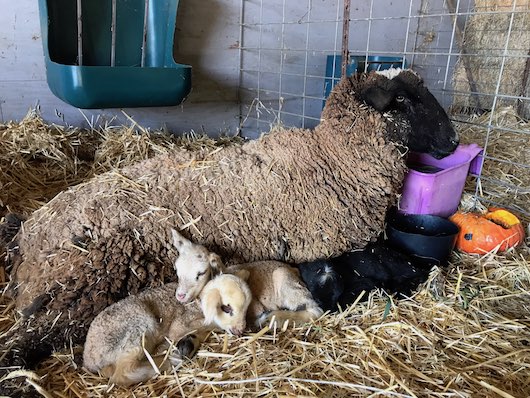
We are so happy to have had rain — and we are hoping for more, much more. This week’s storm is just a start on what the land needs. We woke up last Tuesday morning to frosty and freezing scenery, and a few days later the beautiful sight of a ribbon of snow snaking along the tops of the western hills. Farmers love weather, and this was a big weather week. As the snow melted, the report came that the snow melt could be seen running down the hills and into the Creeks on the Valley floor.


Knowing that the freeze was coming, we set up sprinklers on some of the tender crops like broccoli (above left). The theory with irrigating to protect from freezing temperatures is that as the water freezes on the crops, it releases heat to the air. The goal is to keep the temperature near to the crops a little warmer as ambient temperatures dip down to 27 or 26 degrees. Our hardworking crews also picked ahead, their cold fingers gathering oranges and lettuce, filling every single cooler on the farm to the brim. There’s a funny thing about the way that coolers work when outside temperatures dip below freezing — they are actually used to keep the veggies warm!
We often say that a good storm will bring on lambing season early and that certainly happened this year — what a time for the babies to be born: into a freezing, windy storm. But luckily for them, our shepherds are checking on them round-the-clock, and moving newborns from the pasture into the barn where they will be much warmer and close to their moms so that they don’t get lost. The first lambs were born on Wednesday and by Friday there were already 23 — with yet another 15 on Saturday night and when you read this note, there will surely be many more.
In other important News From the Farm, we have started in on tomato season with saved seeds, seed trays, soil mix and our seasoned greenhouse crew at the ready. Soon, if previous years are a guide, the greenhouses will be full of tomato seedlings. Around here, tomato season lasts about 11 months! The tomato starts are planted early so that we can have them at perfect size as soon as the ground warms up.
It may seem like an odd thing to report, but in an all-time record for the farm, we got three old Ford pickups smogged in one day last week. Getting some of the older vehicles smogged can be a bit of puzzle — What kind of maintenance does it need to pass? Keeping track of the registration and maintenance on all the vehicles that our crews drive hither and yon is an impossible feat. We do our best, and prize the skills of the farm mechanics very highly. Luckily, most of the trucks just need to drive up and down a few farm roads, so if they break down, someone is sure to pass by with a helping hand.
Moving beyond the farm, organic produce sales increased in 2020 by 14.2% over previous years, outpacing conventionally grown produce growth in both sales and volume. The USDA’s National Organic Program reported that the number of certified organic operations worldwide grew in 2020 to 45,578, with 62% of those in the U.S. This growth in organic ag is good news, perhaps a result of the pandemic food system shakeup that has people eating out less and cooking more. But according to the Real Organic Project, of which Full Belly Farm is a proud member, too much of that produce was grown without soil and without adherence to many of the principals and practices that are the bedrock of the organic system. The Real Organic Project is working to educate folks about this problem and lobby for change.
Like the people behind the Real Organic Project, I see organic agriculture as a part of a broad effort to conserve and protect the climate, wildlife and the environment — It makes no sense that organic agriculture would expand without concurrent improvements in water quality and wildlife habitat, let alone the nutritional value of food. Consistent with this philosophy, I was very sad to see the report that the iconic monarch butterfly is dangerously close to extinction. Growing up in Santa Barbara I became familiar with the life history of these butterflies but an annual winter count by the Xerces Society recorded fewer than 2,000 butterflies, which is a massive decline from the tens of thousands in recent years or the millions in the 1980s. Eastern populations have fallen precipitously as well, but the drop in western states presages a complete collapse of the population. In response, the Xerces Society has initiated their Western Monarch Call to Action.
As Full Belly Farm owner Dru Rivers said recently, “There is not one minute to waste! Honestly, I feel that stronger and stronger every day, that we can’t just sit back any more. We need to have action today.” Both groups, the Real Organic Project and the Xerces Society can advise in terms of actions that individuals can take.
— Judith Redmond

Winter Wonderland by Maria Grazia
